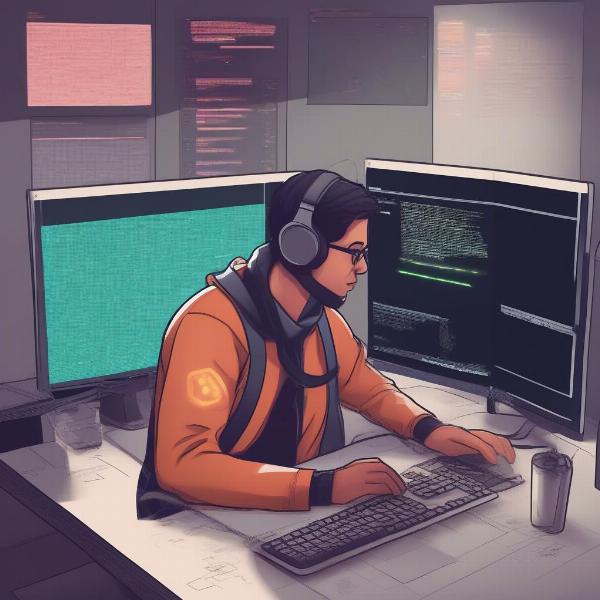The question of whether computer games can cause seizures is a significant one, especially with the increasing popularity of gaming. At SupremeDuelist.blog, we delve into the intricacies of gaming and its impact on health, aiming to provide clear and reliable information. This article will explore the link between computer games and seizures, particularly focusing on photosensitive epilepsy, and provide practical advice for gamers.
We will dissect the scientific understanding of how visual stimuli in games can trigger seizures in susceptible individuals and discuss the precautions gamers can take to minimize their risk. We will also examine the role of game developers in creating safer gaming experiences. Our goal is to make this complex topic understandable and actionable for everyone.
Photosensitive Epilepsy: The Connection to Video Games
Photosensitive epilepsy is a condition where seizures are triggered by visual stimuli, such as flashing lights, certain patterns, or rapidly changing images. While not everyone with epilepsy is photosensitive, those who are can be particularly vulnerable to certain aspects of computer games. The bright lights, fast-paced action, and rapidly changing environments common in many games can be problematic for individuals with this condition. It is crucial to understand that the issue isn’t about the games themselves, but rather the specific visual elements that can act as a trigger.
What Visual Elements in Games Are Most Likely to Trigger Seizures?
Not all games are created equal when it comes to seizure risk. Some specific visual elements are known to be more problematic than others:
- Flickering or Flashing Lights: Rapidly alternating light and dark patterns are perhaps the most common triggers. This effect is often used in games to simulate explosions, lightning, or other visual effects.
- High Contrast Patterns: Geometric shapes with stark contrasts, such as black and white stripes, can also induce seizures in photosensitive individuals. These patterns are sometimes found in level designs or as visual effects.
- Rapidly Changing Images: Games with quickly shifting perspectives or sudden changes in the on-screen visuals can be problematic. The brain can sometimes struggle to process these quick transitions, leading to overstimulation.
- Certain Colors: Although less common, some specific color combinations can also be triggers for some individuals. Bright red or blue hues, especially when combined with flashing effects, can be potent stimuli.
 gaming-epilepsy-awareness-visuals
gaming-epilepsy-awareness-visuals
“The speed and intensity of modern gaming graphics can be a significant risk factor for those with photosensitive epilepsy,” states Dr. Anya Petrova, a leading neurologist specializing in epilepsy research. “It’s important for both gamers and developers to be aware of these triggers and take steps to mitigate them.”
Are There Specific Games That Are More Risky Than Others?
While it’s challenging to create a comprehensive list of “risky” games, certain types of games tend to present more potential triggers than others. Fast-paced action games, especially those with a lot of visual effects, are often cited as having greater risk. Fighting games, first-person shooters, and even some racing games can have many elements that may trigger a seizure in a person with photosensitive epilepsy. Games with a lot of screen clutter, bright contrasting colors, or constant flashing can also pose significant risk. It’s important to be mindful of these potential hazards.
What About Mobile Gaming?
Mobile games also present similar risks, as many incorporate the same visual effects and rapid-paced action. The small screen size, combined with fast-moving images, might even amplify the visual stimuli, making them more potent for some individuals. Gamers should be cautious regardless of whether they are playing on a console, PC, or mobile device.
Steps Gamers Can Take to Reduce Seizure Risk
If you have photosensitive epilepsy or suspect you might be at risk, it’s crucial to take steps to minimize the chances of a seizure while gaming. Here are some practical steps you can take:
- Adjust Game Settings: Many games offer accessibility options that allow you to reduce or disable specific visual effects. Look for settings that allow you to turn off motion blur, flashing lights, or reduce the intensity of colors.
- Take Regular Breaks: Avoid long gaming sessions. Taking frequent breaks can help reduce the cumulative effect of visual stimuli and prevent overstimulation. Try using the 20-20-20 rule, where every 20 minutes you look at something 20 feet away for 20 seconds.
- Play in a Well-Lit Room: Avoid playing in a dark room as this can make the contrast between the game and the surrounding environment more pronounced. A well-lit environment can help reduce eye strain and minimize the intensity of visual stimuli.
- Distance From the Screen: Sit at a reasonable distance from the screen. Being too close can increase visual impact. Adjust the display screen so that it is a comfortable viewing distance, typically at an arm’s length.
- Experiment with Different Display Settings: Adjust the brightness and contrast of your monitor or television to find settings that are comfortable for you. This will also prevent eye strain, which can also contribute to the risk.
- Be Mindful of Game Choice: While playing the latest and greatest game might be exciting, if you’re at risk for photosensitive seizures, you should choose games that are less visually demanding and more comfortable to play.
“A proactive approach to gaming can significantly reduce the risk of seizures,” advises Michael Chen, a game designer with a focus on accessibility. “Adjusting in-game settings and taking frequent breaks are straightforward strategies that can make a big difference.”
The Role of Game Developers
Game developers also play an essential role in creating safer gaming environments. Here are some steps developers can take to minimize seizure risks:
- Implement Accessibility Options: Offering options to disable flashing lights, reduce motion blur, and adjust color contrast can make games more accessible to players with photosensitive epilepsy. This is the most important step game developers can take to ensure their game is safe for the most amount of people.
- Test Games for Seizure Triggers: Thoroughly testing games for potential triggers before release can help identify and address problematic visual elements before they reach players. This should be part of every QA cycle before games are launched.
- Consult with Experts: Working with experts in neurology and epilepsy can help developers better understand the risk factors and develop effective mitigation strategies. They can get direct advice on which effects are more likely to trigger a seizure.
- Provide Warnings: Clearly communicate potential risks to players, especially if a game contains intense visual effects. These should be included on the packaging or in the game’s description and splash screens.
- Create a Diverse Range of Visual Experiences: Not all games need to be filled with flashing lights and fast-paced action. Creating a range of games that offer different visual experiences can cater to a wider audience.
 game-developer-accessibility-design
game-developer-accessibility-design
How Can You Report Issues?
If you find a game that has potential seizure triggers, you can reach out to the game’s developer, and inform them of this. Many developers will appreciate any direct feedback so that they can create better experiences for players. There might also be a community forum, such as Reddit, where you can share your experience and hear from others.
Conclusion
The question of whether computer games can cause seizures is complex, and the answer is yes, particularly for individuals with photosensitive epilepsy. However, with careful precautions, both gamers and developers can reduce the risks. By understanding the specific visual triggers and taking proactive steps to minimize them, we can make gaming a more accessible and safer form of entertainment. SupremeDuelist.blog is dedicated to providing you with this kind of important and helpful information about the world of gaming and technology. Remember to stay informed and always prioritize your well-being while you are enjoying your favorite video games.
If you have any further questions or if there is another gaming related topic that you’d like us to explore, please let us know. Stay tuned to SupremeDuelist.blog for more insightful articles on the ever-evolving world of games!
Leave a Reply